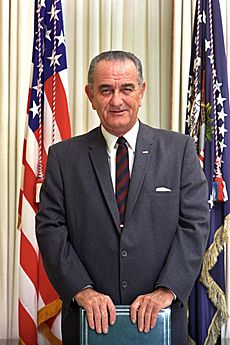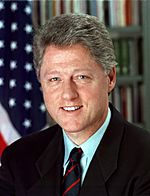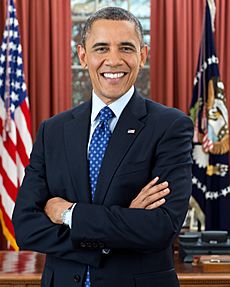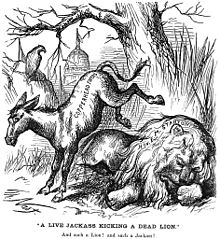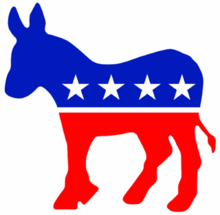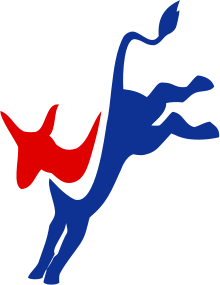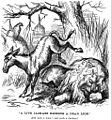History of the United States Democratic Party facts for kids
The Democratic Party of the United States is the oldest voter-based political party in the world, tracing its heritage back to the anti-Federalists of the 1790s. During the "Second Party System", from 1832 to the mid-1850s, under presidents Andrew Jackson, Martin Van Buren, and James K. Polk, the Democrats usually bested the opposition Whig Party by narrow margins. Both parties worked hard to build grassroots organizations and maximize the turnout of voters, which often reached 80 percent or 90 percent. Both parties used patronage extensively to finance their operations, which included emerging big city political machines as well as national networks of newspapers. The Democratic party was a proponent for farmers across the country, urban workers, and new immigrants.(needs citation) It was especially attractive to Irish immigrants who increasingly controlled the party machinery in the cities. The party was much less attractive to businessmen, plantation owners, Evangelical Protestants, and social reformers.(needs citation) The party advocated westward expansion, Manifest Destiny, greater equality among all white men, and opposition to the national banks. In 1860 the Civil War began between the mostly-Republican North against the mostly-Democratic, slave-holding South.
From 1860 to 1932, in the era of the Civil War to the Great Depression, the opposing Republican Party, organized in the mid-1850s from the ruins of the Whig Party and some other smaller splinter groups, was dominant in presidential politics. The Democrats elected only two presidents to four terms of office for 72 years: Grover Cleveland (in 1884 and 1892) and Woodrow Wilson (in 1912 and 1916). Over the same period, the Democrats proved more competitive with the Republicans in Congressional politics, enjoying House of Representatives majorities (as in the 65th Congress) in 15 of the 36 Congresses elected, although only in five of these did they form the majority in the United States Senate. The Party was split between the "Bourbon Democrats", representing Eastern business interests, and the agrarian elements comprising poor farmers in the South and West. The agrarian element, marching behind the slogan of "free silver" (i.e. in favor of inflation), captured the Party in 1896, and nominated the "Great Commoner", William Jennings Bryan in 1896, 1900 and 1908; he lost every time. Both Bryan and Wilson were leaders of the "Progressive Movement", 1890s–1920s.
Starting with 32nd President Franklin D. Roosevelt in 1932 during the Great Depression, the Party dominated the "Fifth Party System", with its liberal/progressive policies and programs with the "New Deal" coalition to combat the emergency bank closings and the continuing financial depression since the famous "Wall Street Crash of 1929" and later going into the crises leading up to the Second World War of 1939/1941 to 1945. The Democrats and the Democratic Party, finally lost the White House and control of the executive branch of government only after Roosevelt's death in April 1945 near the end of the War, and after the continuing post-war administration of Roosevelt's third Vice President of the United States, Harry S Truman, former Senator from Missouri, (for 1945 to 1952, elections of 1944 and the "stunner" of 1948). A new Republican Party president was only elected later in the following decade of the early 1950s with the losses by two-time nominee, the Governor of Illinois, Adlai Stevenson (grandson of the former Vice President with the same name of the 1890s) to the very popular war hero and commanding general in World War II, General Dwight D. Eisenhower (in 1952 and 1956).
With two brief interruptions since the "Great Depression", and World War II eras, the Democrats with unusually large majorities for over four decades, controlled the lower house of the United States Congress in the House of Representatives from 1930 until 1994, and the U.S. Senate for most of that same period, electing the Speaker of the House and the Representatives' majority leaders/committee chairs along with the upper house of the Senate's majority leaders and committee chairmen. Important Democratic progressive/liberal leaders included Presidents: 33rd – Harry S Truman, [of Missouri], (1945–1953), and 36th – Lyndon B. Johnson, [of Texas], (1963–1969), as well as the earlier Kennedy brothers of 35th President John F. Kennedy, [of Massachusetts], (1961–1963), Senators Robert F. Kennedy, of New York, and Senator Edward M. ("Teddy") Kennedy, of Massachusetts who carried the flag for modern American political liberalism. Since the Presidential Election of 1976, Democrats have won five out of the last ten presidential elections, winning in the presidential elections of 1976 (with 39th President Jimmy Carter of Georgia, 1976–1981), 1992 and 1996 (with 42nd President Bill Clinton of Arkansas, 1993–2001), and 2008 and 2012 (with 44th President Barack Obama of Illinois, 2009–2017).
Contents
Origins
1828–1860

The Democratic Party evolved from the Jeffersonian Republican or Democratic-Republican Party organized by Thomas Jefferson and James Madison in opposition to the Federalist party of Alexander Hamilton and John Adams. The party favored republicanism, a weak federal government, states' rights, agrarian interests (especially Southern planters) and strict adherence to the Constitution; it opposed a national bank, close ties to Great Britain, and business and banking interests. That party, the Democratic-Republican Party, came to power in the election of 1800.
After the War of 1812 the Federalists virtually disappeared and the only national political party left was the Democratic-Republicans. The era of one-party rule in the United States, known as the Era of Good Feelings, lasted from 1816 until the early 1830s, when the Whig Party became a national political group to rival the Democratic-Republicans. The Democratic-Republican party still had its own internal factions, however. They split over the choice of a successor to President James Monroe, and the party faction that supported many of the old Jeffersonian principles, led by Andrew Jackson and Martin Van Buren, became the modern Democratic Party. As Norton explains the transformation in 1828:
Jacksonians believed the people's will had finally prevailed. Through a lavishly financed coalition of state parties, political leaders, and newspaper editors, a popular movement had elected the president. The Democrats became the nation's first well-organized national party ... and tight party organization became the hallmark of nineteenth-century American politics.
Opposing factions led by Henry Clay helped form the Whig Party. The Democratic Party had a small but decisive advantage over the Whigs until the 1850s, when the Whigs fell apart over the issue of slavery. In 1854, angry with the Kansas–Nebraska Act, anti-slavery Democrats left the party and joined Northern Whigs to form the Republican Party.
Behind the platforms issued by state and national parties stood a widely shared political outlook that characterized the Democrats:
The Democrats represented a wide range of views but shared a fundamental commitment to the Jeffersonian concept of an agrarian society. They viewed the central government as the enemy of individual liberty. The 1824 "corrupt bargain" had strengthened their suspicion of Washington politics. ... Jacksonians feared the concentration of economic and political power. They believed that government intervention in the economy benefited special-interest groups and created corporate monopolies that favored the rich. They sought to restore the independence of the individual—the artisan and the ordinary farmer—by ending federal support of banks and corporations and restricting the use of paper currency, which they distrusted. Their definition of the proper role of government tended to be negative, and Jackson's political power was largely expressed in negative acts. He exercised the veto more than all previous presidents combined. Jackson and his supporters also opposed reform as a movement. Reformers eager to turn their programs into legislation called for a more active government. But Democrats tended to oppose programs like educational reform mid the establishment of a public education system. They believed, for instance, that public schools restricted individual liberty by interfering with parental responsibility and undermined freedom of religion by replacing church schools. Nor did Jackson share reformers' humanitarian concerns. He had no sympathy for American Indians, initiating the removal of the Cherokees along the Trail of Tears.
1860–1900
The Democrats split over the choice of a successor to President James Buchanan along Northern and Southern lines; factions of the party provided two separate candidacies for president in the election of 1860, in which the Republican Party gained ascendancy. The radical pro-slavery Fire-Eaters led a walkout at both the April Democratic convention in Charleston's Institute Hall and the June convention in Baltimore when the national party would not adopt a resolution supporting the extension of slavery into territories even if the voters of those territories did not want it. These Southern Democrats nominated the pro-slavery incumbent vice president, John C. Breckinridge of Kentucky, for president and General Joseph Lane, former Governor of Oregon, for vice president. The Northern Democrats nominated Senator Stephen A. Douglas of Illinois for president and former Governor of Georgia Herschel V. Johnson for vice president, while some southern Democrats joined the Constitutional Union Party, backing its nominees (who had both been prominent Whig leaders), former Senator, Speaker of the House, and Secretary of War John Bell of Tennessee for president and the politician, statesman, and educator Edward Everett of Massachusetts for vice president. This fracturing of the Democrats led to a Republican victory, and Abraham Lincoln was elected the 16th President of the United States.
As the American Civil War broke out, Northern Democrats were divided into War Democrats and Peace Democrats. The Confederate States of America, whose political leadership, mindful of the welter prevalent in antebellum American politics and with a pressing need for unity, largely viewed political parties as inimical to good governance; consequently the Confederacy had none, or at least none with the wide organization inherent to other American parties. Most War Democrats rallied to Republican President Abraham Lincoln and the Republicans' National Union Party in the election of 1864, which featured Andrew Johnson on the Republican ticket even though he was a Democrat from the South. Johnson replaced Lincoln in 1865, but stayed independent of both parties. The Democrats benefited from white Southerners' resentment of Reconstruction after the war and consequent hostility to the Republican Party. After Redeemers ended Reconstruction in the 1870s, and following the often extremely violent disenfranchisement of African Americans led by such white supremacist Democratic politicians as Benjamin Tillman of South Carolina in the 1880s and 1890s, the South, voting Democratic, became known as the "Solid South". Though Republicans won all but two presidential elections, the Democrats remained competitive. The party was dominated by pro-business Bourbon Democrats led by Samuel J. Tilden and Grover Cleveland, who represented mercantile, banking, and railroad interests; opposed imperialism and overseas expansion; fought for the gold standard; opposed bimetallism; and crusaded against corruption, high taxes, and tariffs. Cleveland was elected to non-consecutive presidential terms in 1884 and 1892.
1900–1930
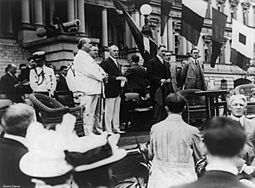
Agrarian Democrats demanding Free Silver overthrew the Bourbon Democrats in 1896 and nominated William Jennings Bryan for the presidency (a nomination repeated by Democrats in 1900 and 1908). Bryan waged a vigorous campaign attacking Eastern moneyed interests, but he lost to the Republican William McKinley. The Democrats took control of the House in 1910 and elected Woodrow Wilson as president in 1912 and 1916. Wilson effectively led Congress to put to rest the issues of tariffs, money, and antitrust, which had dominated politics for 40 years, with new progressive laws.
1930–1960
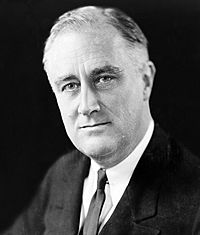
The Great Depression in 1929 that occurred under Republican President Herbert Hoover and the Republican Congress set the stage for a more liberal government; the Democrats controlled the House of Representatives nearly uninterrupted from 1930 until 1994 and won most presidential elections until 1968. Franklin D. Roosevelt, elected to the presidency in 1932, came forth with government programs called the New Deal. New Deal liberalism meant the regulation of business (especially finance and banking) and the promotion of labor unions, as well as federal spending to aid to the unemployed, help distressed farmers, and undertake large-scale public works projects. It marked the start of the American welfare state. The opponents, who stressed opposition to unions, support for business, and low taxes, started calling themselves "conservatives".
Until the 1980s, the Democratic Party was a coalition of two parties divided by the Mason–Dixon line: liberal Democrats in the North and culturally conservative voters in the South, who though benefitting from many of the New Deal public works projects, opposed increasing Civil Rights initiatives advocated by Northeastern liberals. The polarization grew stronger after Roosevelt died. Southern Democrats formed a key part of the bipartisan conservative coalition in an alliance with most of the Midwestern Republicans. The economically activist philosophy of Franklin D. Roosevelt, which has strongly influenced American liberalism, shaped much of the party's economic agenda after 1932. From the 1930s to the mid-1960s, the liberal New Deal coalition usually controlled the Presidency while the conservative coalition usually controlled Congress.
Issues facing parties and the United States after World War II included the Cold War and the Civil Rights Movement. Republicans attracted conservatives and white Southerners from the Democratic coalition with their use of the Southern strategy and resistance to New Deal and Great Society liberalism. African Americans had traditionally supported the Republican Party because of the anti-slavery policies of Abraham Lincoln and the civil rights policies of his successors, such as Ulysses S. Grant. But they began supporting Democrats following the ascent of the Franklin D. Roosevelt administration, the New Deal, the integration of the military and embrace of proposed civil rights legislation by President Harry Truman in 1947–48, and the postwar Civil Rights movement. The Democratic Party's main base of support shifted to the Northeast, marking a dramatic reversal of history.
1960–1980
The election of President John F. Kennedy from Massachusetts in 1960 was a partial reflection of this shift. In the campaign, Kennedy attracted a new generation of younger voters. In his agenda dubbed the New Frontier, Kennedy introduced a host of social programs and public works projects, along with enhanced support of the space program, proposing a manned spacecraft trip to the moon by the end of the decade. He pushed for civil rights initiatives and proposed the Civil Rights Act of 1964, but with his assassination in November 1963, was not able to see its passage.
Kennedy's successor Lyndon B. Johnson was able to persuade the largely conservative congress to pass civil rights bill in 1964 and with a more progressive congress in 1965 passed much of the Great Society, which consisted of an array of social programs designed to help the poor. Kennedy and Johnson's advocacy of civil rights further solidified black support for the Democrats, but had the effect of alienating southern whites, who would eventually gravitate towards the Republican party, particularly after the election of Ronald Reagan to the presidency in 1980. The United States' involvement in the Vietnam War in the 1960s was another divisive issue that further fractured the fault lines of the Democrats' coalition. After Gulf of Tonkin Resolution in 1964, President Johnson committed a large contingency of combat troops to Vietnam, but the escalation failed to drive the Viet Cong from south Vietnam, resulting in an increasing quagmire, which by 1968 had become the subject of widespread anti-war protests in the United States and elsewhere. With increasing casualties and nightly news reports bringing home troubling images from Vietnam, the costly military engagement became increasingly unpopular, alienating many of the kinds of young voters that the Democrats had attracted the early 1960s. The protests that year along with assassinations of Dr. Martin Luther King, Jr. and Democratic presidential candidate Sen. Robert F. Kennedy (younger brother of John F. Kennedy) climaxed in turbulence at the hotly contested Democratic National Convention that summer in Chicago (which, amongst the ensuing turmoil inside and outside of the convention hall, nominated Vice President Hubert Humphrey), in a series of events that proved to mark a significant turning point in the decline of the Democratic party's broad coalition.
Republican presidential nominee Richard Nixon was able to capitalize on the Democrat's confusion that year and won the 1968 election to become the 37th president, and would win again in 1972 against Democratic nominee George McGovern, who like Robert Kennedy reached out to the younger anti-war and counterculture voters, but unlike Kennedy, was not able to appeal to the party's more traditional white working class constituencies. During Nixon's second term, his presidency was rocked by the Watergate scandal, which forced him to resign in 1974, being succeeded by vice president Gerald Ford, who served a brief tenure. Watergate offered the Democrats an opportunity to recoup, and their nominee Jimmy Carter won the 1976 presidential election. With the initial support of evangelical Christian voters in the South, Carter was temporarily able to re-unite the disparate factions within the party, but inflation and the Iran Hostage Crisis of 1979–1980 took their toll, resulting in a landside victory for Republican presidential nominee Ronald Reagan in 1980, which shifted the tectonic plates of the political landscape in favor of the Republicans for years to come.
1980–present
With the ascendancy of the Republicans under Ronald Reagan, the Democrats searched for ways to respond, but were unable to succeed by running traditional candidates, such as former Vice President and Democratic presidential nominee Walter Mondale who lost to Reagan in the 1984 presidential election. Many Democrats attached their hopes to the future star of Gary Hart, who had challenged Mondale in the 1984 primaries running on a theme of "New Ideas", and in the subsequent 1988 primaries, he became the de facto front-runner and virtual "shoe-in" for the Democratic presidential nomination, before his campaign was ended. The party nevertheless began to seek out a younger generation of leaders, who like Hart had been inspired by the pragmatic idealism of John F. Kennedy.
Arkansas governor Bill Clinton was one such figure, who was elected President in 1992 as the Democratic nominee. He labeled himself and governed as a "New Democrat". The party adopted a centrist economic but socially progressive agenda, with the voter base after Reagan having shifted considerably to the right. In an effort to appeal to both liberals and fiscal conservatives, Democrats began to advocate for a balanced budget and market economy tempered by government intervention (mixed economy), along with a continued emphasis on social justice and affirmative action. The economic policy adopted by the Democratic Party, including the former Clinton administration, has been referred to as "Third Way". The Democrats lost control of Congress in the election of 1994 to the Republican Party. Re-elected in 1996, Clinton was the first Democratic President since Franklin Roosevelt to be elected to two terms. Following twelve years of Republican rule, the Democrats regained majority control of both the House and the Senate in the 2006 elections.
In the wake of the 2001 World Trade Center terrorist attacks and with growing concern over global warming, some of the party's key issues in the early 21st century have included the methods of how to combat terrorism, homeland security, expanding access to health care, labor rights, environmentalism, and the preservation of liberal government programs. Barack Obama won the Democratic Party's nomination and was elected as the first African American president in 2008. The Democrats gained control of both chambers of Congress in the wake of the 2007 economic recession. The Democratic Party under the Obama presidency moved forward reforms including an Economic Stimulus package, the Dodd-Frank financial reform act, and the Affordable Care Act. In the 2010 elections, the Democratic Party lost control of the House and lost its majority in state legislatures and state governorships. In the 2012 elections, President Obama was re-elected but the party kept its minority in the House of Representatives, and in 2014 the party lost control of the Senate for the first time since 2006. After the 2016 election of Donald Trump, the Democratic Party transitioned into the role of an opposition party and currently hold neither the Presidency nor a majority in the House or Senate.
According to a Pew Research poll, the Democratic Party has become more socially liberal and secular compared to how it was in 1987. Based on a poll conducted in 2014, Gallup found that 30% of Americans identified as Democrats, 23% as Republicans, and 45% as Independents. In the same poll, a survey of registered voters stated that 47% identified as Democrats or leaned towards the party; the same poll found that 40% of registered voters identified as Republicans or leaned towards the Republican party.
Name and symbols
Initially calling itself the "Republican Party," Jeffersonians were labeled "Democratic" by the opposition Federalists, with the hope of stigmatizing them as purveyors of democracy or mob rule. By the Jacksonian era, the term "The Democracy" was in use by the party; the name "Democratic Party" was eventually settled upon and became the official name in 1844. Members of the party are called "Democrats" or "Dems".
The term "Democrat Party" has also been in local use but has usually been used by opponents since 1952 as an epithet.
The most common mascot symbol for the party has been the donkey, or jackass. Andrew Jackson's enemies twisted his name to "jackass" as a term of ridicule regarding a stupid and stubborn animal. However, the Democrats liked the common-man implications and picked it up too, so the image persisted and evolved. Its most lasting impression came from the cartoons of Thomas Nast from 1870 in Harper's Weekly. Cartoonists followed Nast and used the donkey to represent the Democrats, and the elephant to represent the Republicans.
In the early 20th century, the traditional symbol of the Democratic Party in Indiana, Kentucky, Oklahoma and Ohio was the rooster, as opposed to the Republican eagle. This symbol still appears on Oklahoma, Kentucky, Indiana, and West Virginia ballots. The rooster was adopted as the official symbol of the national Democratic party. In New York, the Democratic ballot symbol is a five-pointed star.
Although both major political parties (and many minor ones) use the traditional American colors of red, white, and blue in their marketing and representations, since election night 2000, blue has become the identifying color for the Democratic Party, while red has become the identifying color for the Republican Party. That night, for the first time, all major broadcast television networks used the same color scheme for the electoral map: blue states for Al Gore (Democratic nominee) and red states for George W. Bush (Republican nominee). Since then, the color blue has been widely used by the media to represent the party. This is contrary to common practice outside of the United States where blue is the traditional color of the right and red the color of the left. For example, in Canada, red represents the Liberals, while blue represents the Conservatives. In the United Kingdom, red denotes the Labour Party and blue symbolizes the Conservative Party. Blue has also been used both by party supporters for promotional efforts—ActBlue, BuyBlue, BlueFund, as examples—and by the party itself in 2006 both for its "Red to Blue Program", created to support Democratic candidates running against Republican incumbents in the midterm elections that year, and on its official website.
In September 2010, the Democratic Party unveiled its new logo, which featured a blue D inside a blue circle. It was the party's first official logo, as the donkey logo had only been semi-official.
Jefferson-Jackson Day is the annual fundraising event (dinner) held by Democratic Party organizations across the United States. It is named after Presidents Thomas Jefferson and Andrew Jackson, whom the party regards as its distinguished early leaders.
The song "Happy Days Are Here Again" is the unofficial song of the Democratic Party. It was used prominently when Franklin D. Roosevelt was nominated for president at the 1932 Democratic National Convention and remains a sentimental favorite for Democrats today. For example, Paul Shaffer played the theme on the Late Show with David Letterman after the Democrats won Congress in 2006. "Don't Stop" by Fleetwood Mac was adopted by Bill Clinton's presidential campaign in 1992, and has endured as a popular Democratic song. Also, the emotionally similar song "Beautiful Day" by the band U2 has become a favorite theme song for Democratic candidates. John Kerry used the song during his 2004 presidential campaign, and several Democratic Congressional candidates used it as a celebratory tune in 2006.
The 2016 campaign of US Democratic Party presidential candidate Bernie Sanders used the hopeful Simon & Garfunkel song America for one of its campaign advertisements, with the complete permission of the still-active duo of popular American musicians. As a traditional anthem for its Presidential nominating convention, Aaron Copland's Fanfare for the Common Man is traditionally performed at the beginning of the Democratic National Convention.
Images for kids
-
Andrew Jackson, founder of the Democratic Party and the first president it elected.
-
To vote for Stephen A. Douglas in Virginia, a man deposited the ticket issued by the party in the official ballot box
-
Thomas Nast's January 1870 depiction of the Democratic donkey
-
Typewriters were new in 1893 and this Gillam cartoon from Puck shows that Grover Cleveland can not get the Democratic "machine" to work as the keys (key politicians) will not respond to his efforts
-
William Jennings Bryan at age 36 was the youngest candidate, October 1896
-
Adlai Stevenson warns against a return of the Republican policies of Herbert Hoover, 1952 campaign poster
-
President John F. Kennedy with his brothers, Attorney General and later New York Senator Robert F. Kennedy and Massachusetts Senator Ted Kennedy
-
President Jimmy Carter was elected in 1976 and defeated in 1980
-
Representative Thomas "Tip" O'Neill was Speaker of the House (1977–1987) and was the highest ranking Democrat in Washington, D.C. during most of Reagan's term
-
Nancy Pelosi of California was the first woman to serve as Speaker of the House of Representatives
-
On November 4, 2008, Barack Obama was elected as the first African American president of the United States
-
Former Secretary of State Hillary Clinton
-
Senator Bernie Sanders
-
Nancy Pelosi, the current House Speaker (2019–present), was highly visible adversary for President Trump.



